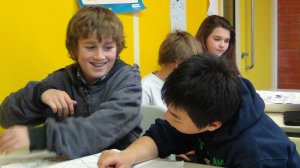Talking to Learn: Harnessing the Power of Student Conversation
At some point, all teachers have experienced the struggle against student chatter in the classroom - so how can student conversations be structured to enhance learning?

Our research was conducted through a project with the ACS Centre for Inspiring Minds with the goal of providing teachers with the time and resources to create, reflect, and share effective methods in student dialogue. We included students to get perspectives from all stakeholders in the learning process; they provided us with valuable data on determining the effect of participating in structured speaking activities:
69% of the students surveyed believe that speaking or listening is the most important academic skill (over reading or writing). However, 73% reported receiving the least amount of classroom instruction on how to effectively speak or listen; research on language use has shown that approximately 40% of class time should be used in dialogue in order to maximise effective learning.
We found increased interaction opportunities lead specifically to the following:
Content Understanding
“One of the best moments I had in teaching this term was...they were really working hard in all these little groups, and you could hear all these conversations going on asking questions, whatever, because they knew it was ok to do that, it was to get help,” reported an 8th grade teacher, “and I could feel tingles going down my spine just watching how into it they were just talking about Newton’s Laws.” A fifth grade math student clarified the point in his own words: “Normally when [teachers] ask you to do something you say that’s easy, but when you have to do it, it gets harder.”
Academic Language Use
As a seventh grade social studies ELL student explained, “Talking is good to improve your communication skills, and good to improve English skills too.” One seventh grade math teacher supported the idea that the format of the activities assists with vocabulary retention: “Rather than letting them loose...it does need to be slightly contrived to encourage them to use the vocabulary because they they wouldn’t do it as a natural thing.”
Engagement and Motivation
“Because the students became the instructors through helping each other, my role was just to facilitate their individual conversations as needed,” explained a sixth grade technology teacher. A social studies teacher contrasted students sharing their work with a partner to presenting in a whole-class format: “Most students don’t listen to presentations. They are switched off after four or five. This [activity] forced them to interact with each other.” A student in the class was asked to address the same topic. Without hesitation he responded, “I listened more [during the pair activity] than the presentation.”
New Assessments
One teacher best verbalized the feelings of middle school teachers and students when she said, “I think, by making it an assessed piece of work, the students feel it is more valued.” Assessing speaking activities still granted students with choice and ownership over the direction of the conversations, while also holding them accountable for use of the dialoguing skills. The result: “I tried to describe what he said. Not just copy and paste what he said. This was the first time I really listened [to a classmate].”
As you can imagine, there are many places student dialogue can go, and we're looking forward to continuing to discover how students can learn from each other through this initiative. It has pretty exciting to see it unfold so far. We’d love to hear about your experiences with academic conversations in your classroom!
P.S. Our research is published in a free interactive eBook, Talking in Class. The book is full of short video clips of teachers and students talking about and engaged in student-to-student dialogue activities.